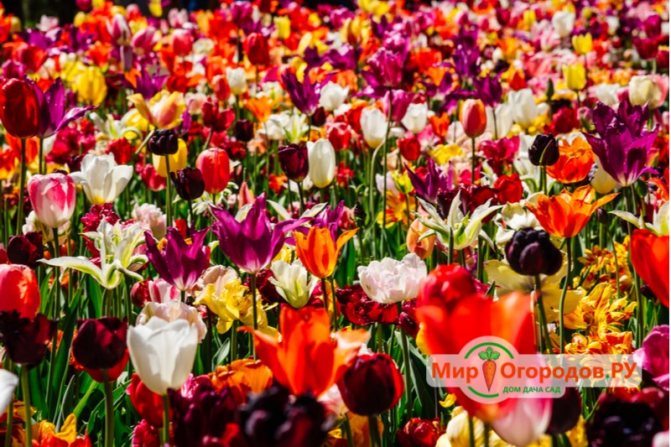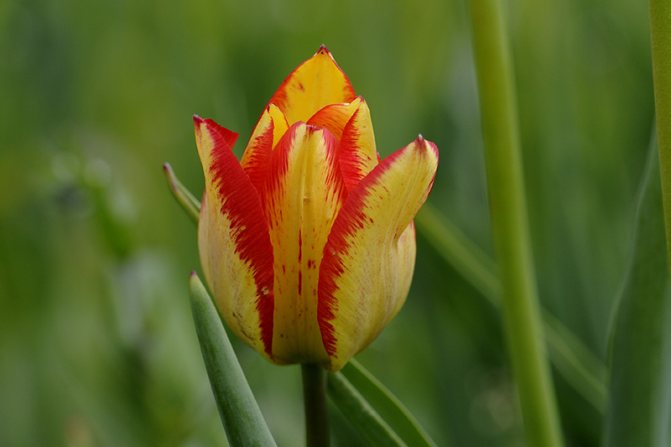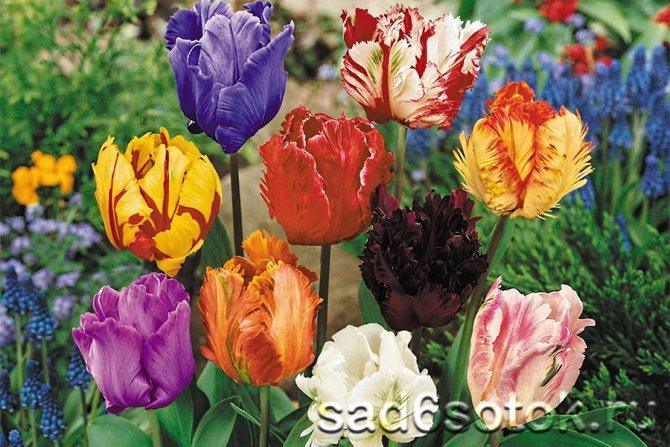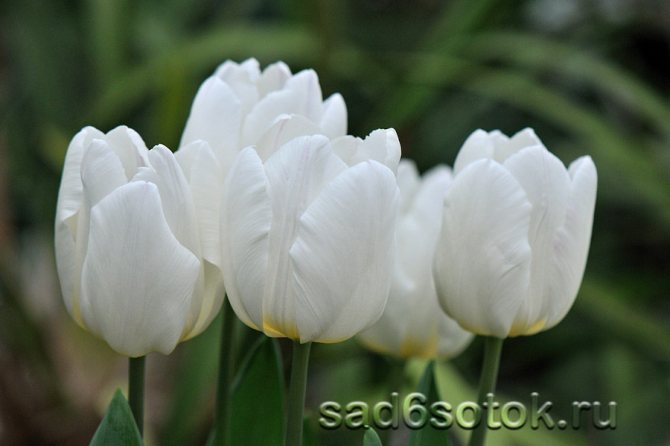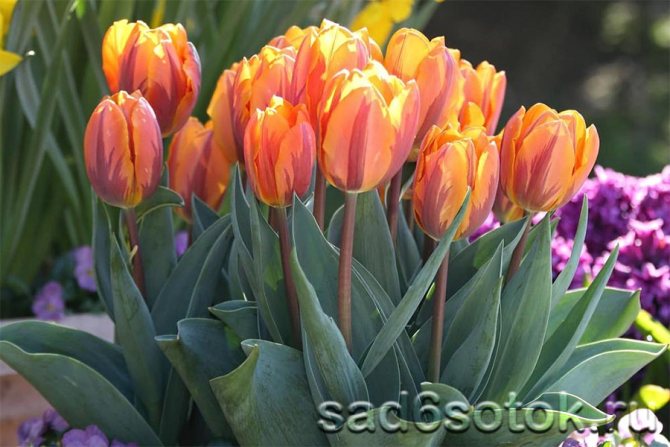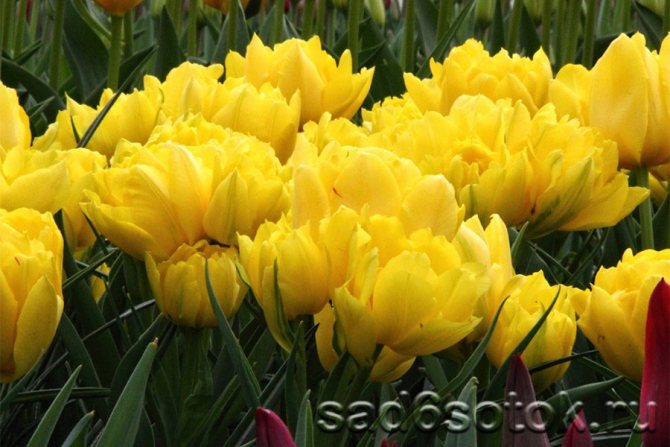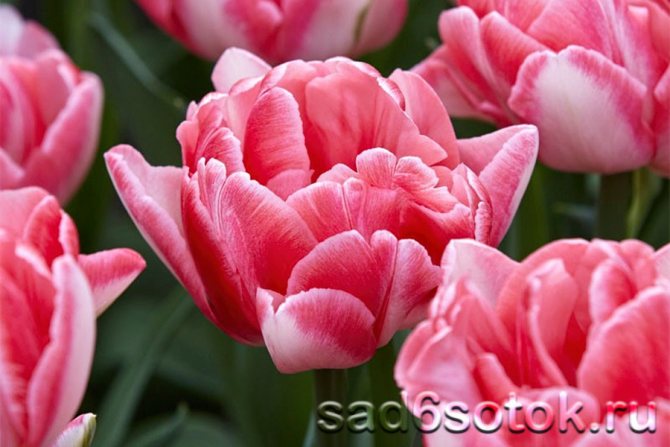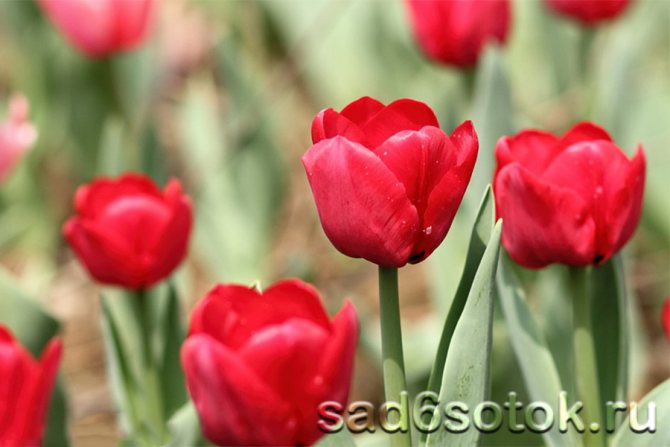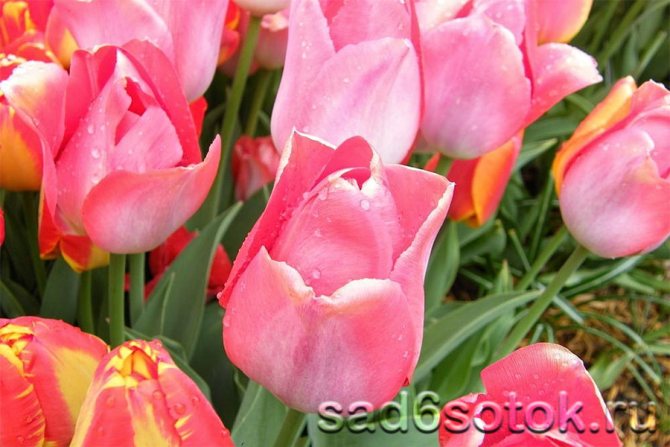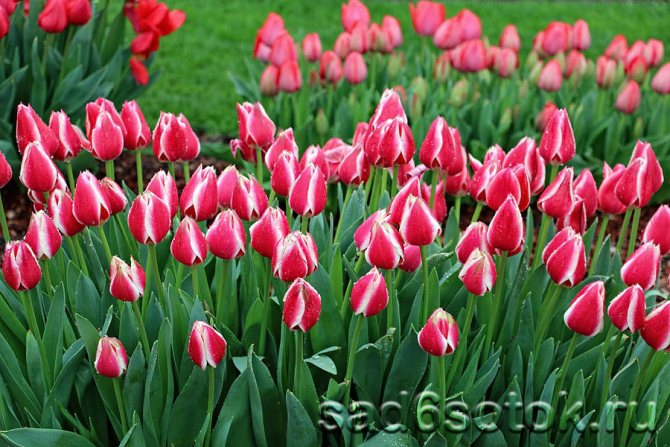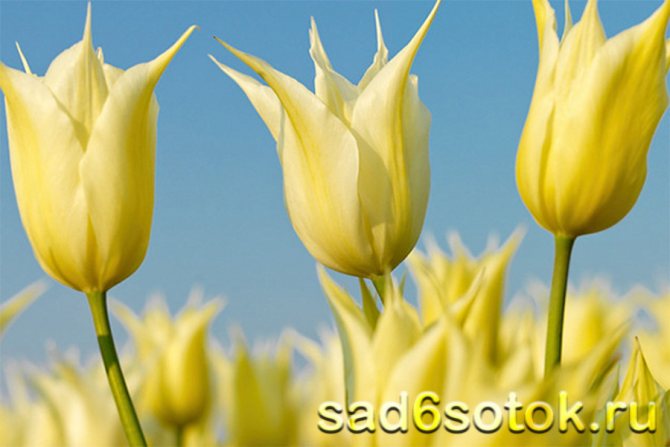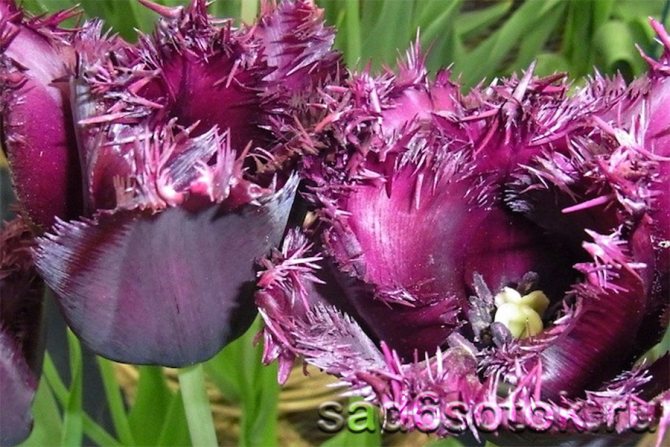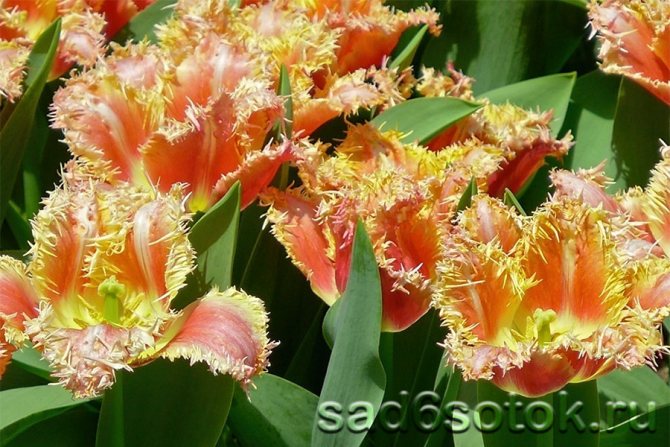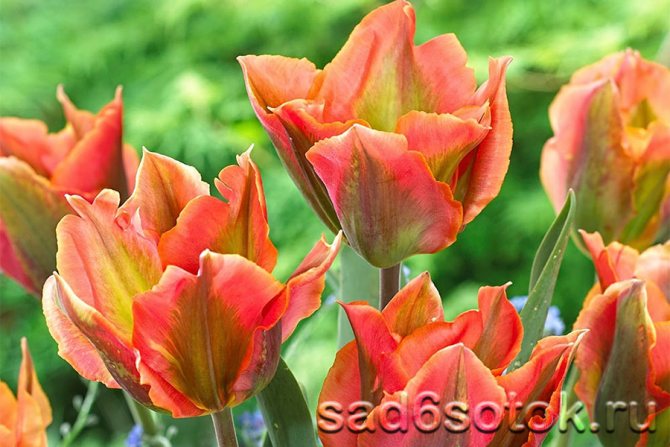Tulip: description
- If we talk about tulips, then they had to go a long way. These flowers were first mentioned in Persia. It was only by the middle of the 16th century that tulips were brought to Europe, where they were quite successfully introduced. Some peoples, for example, the Dutch, even had farms and industries for the cultivation of these plants.
- Tulips are considered spring flowers, a symbol of warmth and spring.
- The tulip is a herbaceous plant that is characterized by a fairly short growing season.
- The tulip is one of the fastest growing plants. It can grow up to 2 centimeters per day. This type of flower grows in a vase of water after being cut.
- Tulip bulbs are pear-shaped or egg-shaped. On top of them there is a covering scales. In the description of the tulip bulb, a pointed top and a flattened bottom are clearly traced. The size of this part of the flower, the shape of the scales and color may differ depending on the variety.
- In a tulip, the root is located at the bottom of the bulb. At the young seedling stage, this plant has one main root, which dies out at the end of the first growing season.
- Tulip leaves have an elongated-pointed or elongated-oval shape. They clasp the stem tightly. Some varieties of tulips have ridged growths on the surface of the leaf.
- Tulip flowers consist of 3 inner and 3 outer petals. Hybrid species of this plant may have more petals. Most often, there is one bud on one plant, but there are varieties of tulips that are characterized by the development of several buds.
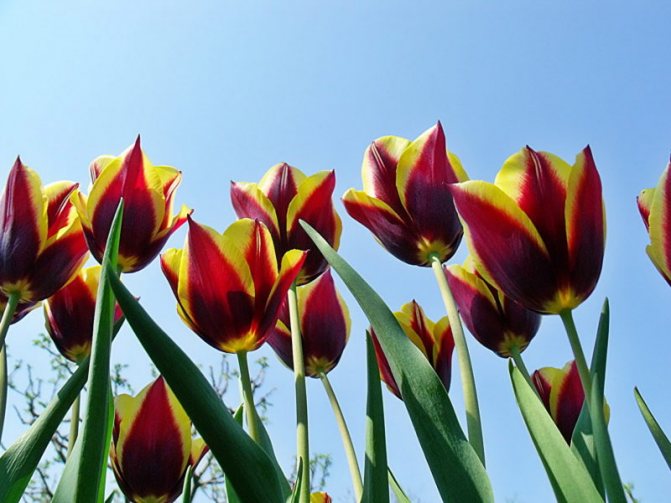
3.When it blooms
The onset of flowering will depend on both external factors, such as weather conditions, and the type of plant. As a general rule, lily-colored varieties are the first to bloom - in April.
If the plant is planted in a sunny place, then flowering will come earlier, but also finish faster. When grown in partial shade, flowering will come later, but the buds will remain attractive for a longer period of time.
↑ Up,
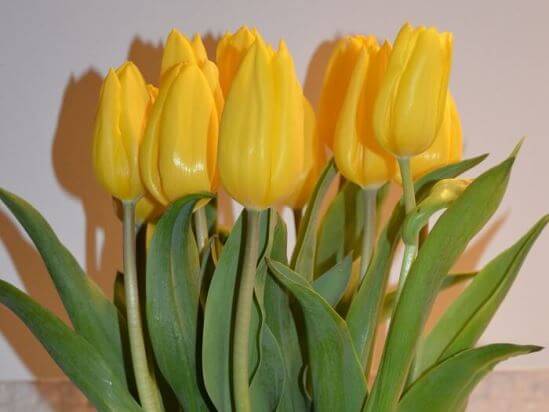

The vast majority of species bloom in May, the flowering period usually lasts 2 to 3 weeks.
Interestingly, in the first 1 - 2 days, the buds can remain half-open, and as they bloom, the petals will diverge more and more. In addition, in cloudy, rainy weather or in the evening and night hours, the flowers are able to remain closed.
↑ Up,


Types and varieties of tulips
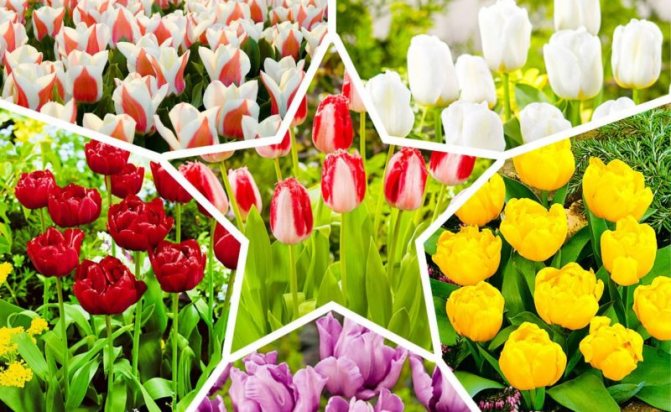

- The great tulip is a perennial bulbous plant, the height of which can reach 45 centimeters. This flower has broad leaves of a bluish-green hue and single goblet flowers. The flowering period for this tulip variety can begin at the end of April.
- The hairy-lamellar tulip is a perennial bulbous plant with a height of up to 25 centimeters and with smooth linear leaves of a light green tone. Flowers in this species are solitary and can be up to 5 centimeters in diameter. Usually these tulips are golden yellow. Their flowering begins in mid-April and ends in early May.
- The Kaufman tulip is a bulbous plant, the stem of which can be up to 20 centimeters high.This plant has wide leaves with dark veins and single flowers up to 8 centimeters in diameter. The outer surface of these flowers is yellow, and the throat is raspberry pink. The flowering of this plant begins in mid-April.
- The excellent tulip is a perennial bulbous plant with a height of up to 30 centimeters. The leaves of such a tulip are wavy and bent. The flowers of this plant are wide open, and reach up to 14 centimeters in diameter. The flowering period of such a tulip begins in early May and lasts about 10 days.
- The Bieberstein tulip is a bulbous perennial flower that is characterized by slender gray-green stems, which reach a height of 30 centimeters. The bud of this type of tulip is drooping, and the flower is wide open and has a star-shaped shape. Usually these flowers are golden yellow or white. These tulips begin to bloom in April-May.
Read also: Rafflesia Arnold flower weighs more than 8 kg and has a diameter of about a meter
8 distillation at home
During the transplantation period, strong, healthy bulbs are selected, cleaned of soil, dried and treated with fungicides. Such planting material is stored until October, then planted in pots. For distillation, pots with large drainage holes are selected and a moisture-wicking layer of broken brick or expanded clay is placed on their bottom.
The pots are filled with nutritious flower soil based on sod and leaf humus and peat. A sufficient amount of river sand or perlite and vermiculite is mixed into the soil.
↑ Upward,
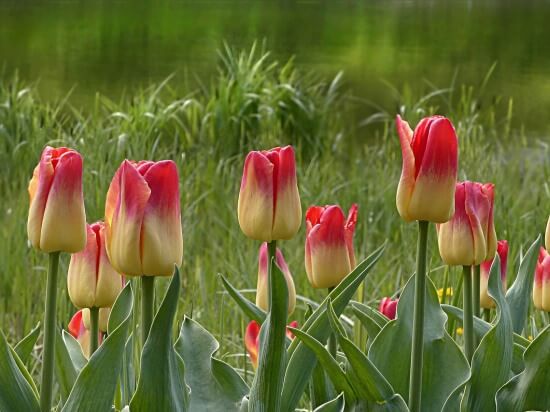

Tulip bulbs are placed in the ground so that a distance of 2 - 3 cm remains between them and the walls of the pot. The number of bulbs, respectively, will depend on the diameter of the pot.
Each bulb has a plane on one side - when planting, it is worth marking it so that it looks at the wall of the pot. If the bulbs are oriented correctly, the leaves will be directed to the sides and will be beautifully outweighed over the walls of the container. Sprinkle the bulbs on top with soil so that they are sprinkled on top with a layer of earth about 2 cm thick.
↑ Upward,
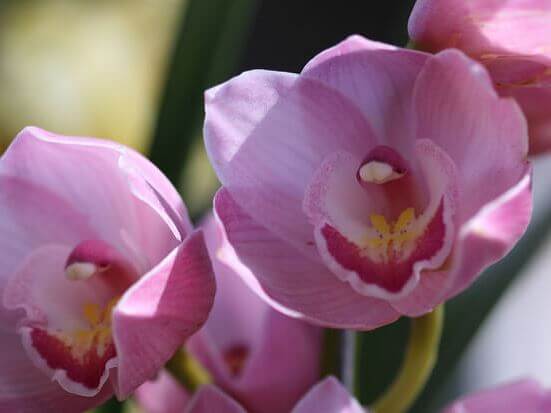

Such plantings are stored in a cool and dark place - for example, in a cellar or on a balcony, at a temperature of 5 - 7 degrees Celsius, covering the top with black polyethylene. The soil in pots is slightly moistened every 1 - 2 weeks, preventing it from completely drying out.
In order to get the buds by the desired date, it is worth familiarizing yourself with the varietal characteristics of the flower - the timing of flowering. 1 - 2 months before this date, the pots with bulbs are placed in a sufficiently warm and bright place, open and begin to water a little. The frequency of watering is gradually increased as the leaves and buds form.
↑ Upward,
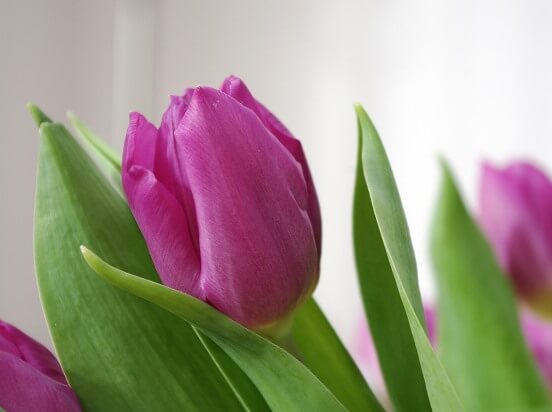

Since there is only a limited nutritional area in the pot, the plants must be fed with mineral fertilizers for flowering plants every 10 days.
It is advisable to keep the flowering bush at a temperature of 16 - 20 degrees. In warmer conditions, flowering times may be shorter.
The bulbs in the process of forcing lose too much energy after the ground part dies, they are dried and disinfected, and then planted in the garden so that it grows up nutrients. They can be reused for distillation after 2 - 3 years.
↑ Upward,
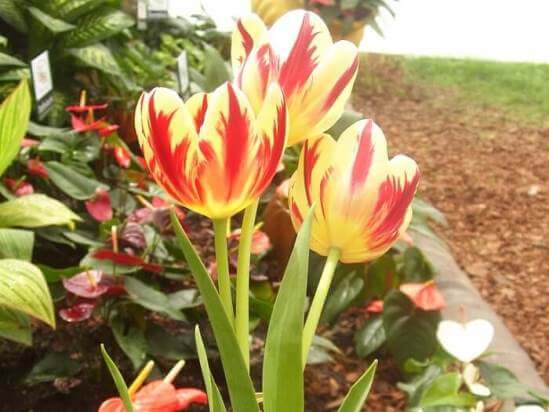

Where do tulips grow?
- In nature, tulips are found in the center of Asia, especially in Tajikistan and Turkmenistan, in Uzbekistan and Pakistan, in India and Nepal, as well as in Mediterranean countries such as Morocco and Spain, Italy and the Netherlands.
- These flowers are common in the Balkans and in the rather harsh Scandinavia.
- Many varieties of this plant grow in private household plots and in urban flower beds in Eastern Europe and the former Soviet Union.
- Tulips easily manage to withstand the climate of desert, mountain and steppe regions, as well as harsh winters and dry summers.
9 reproduction
Both seed and vegetative propagation with the help of small daughter bulbs are possible.
↑ Up,
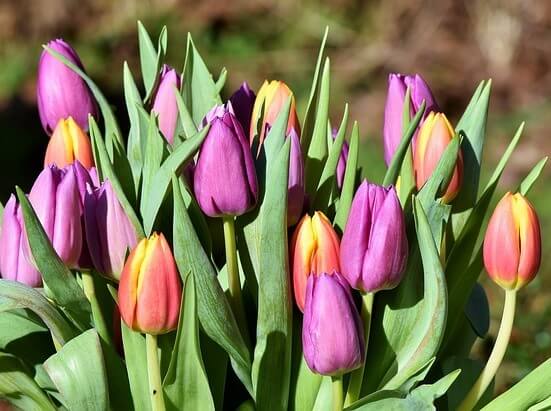

9.1 Growing tulips from seeds
It is worth remembering that not all plants are capable of forming seeds after flowering. In addition, during seed reproduction, the varietal characteristics of the bushes are lost and the offspring are often strikingly different from the parent bushes in their appearance. Only species tulips fully retain their attractiveness with this method of reproduction.
↑ Up,
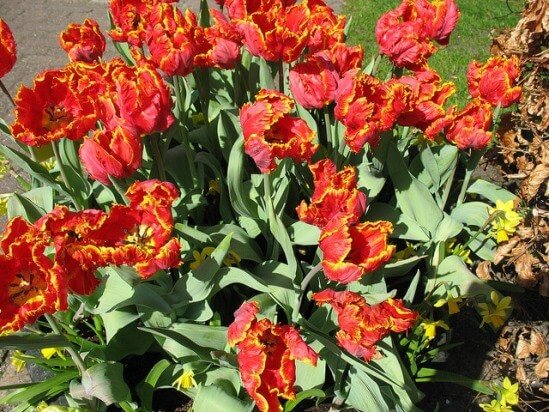

When growing a tulip from seeds, flower growers should be patient - the first buds will appear on such specimens only 3-7 years after sowing the seeds and the flowers can be small and inconspicuous. Full bloom often occurs only at 8-10 years of age. In everyday life, seed reproduction is used extremely rarely, since the result is not guaranteed, however, it is often used by breeders to breed new varieties of flowers.
↑ Up,
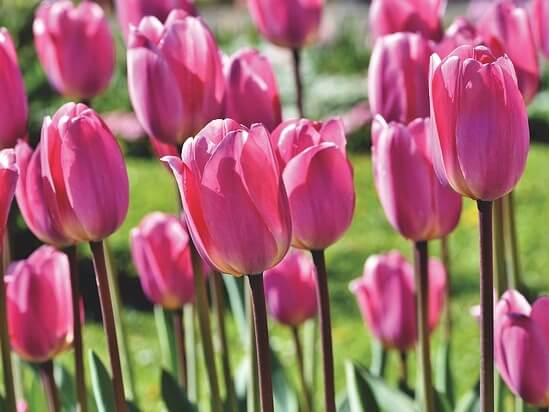

Seeds are picked from fully ripe seed pods and slightly dried in a warm and ventilated area. Sowing is carried out before winter in such a way that the sprouts do not have time to appear before the onset of winter. Seeds are placed in grooves about 1.5 cm deep, sprinkled with soil and, with the onset of night frosts, are covered with non-woven material. The first shoots will appear only next spring.
Small bushes do not disturb the transplant for another 2 - 3 years, providing them with timely shelter in winter. Only in the fourth year are the bulbs dug up, dried and planted in the fall.
↑ Up,
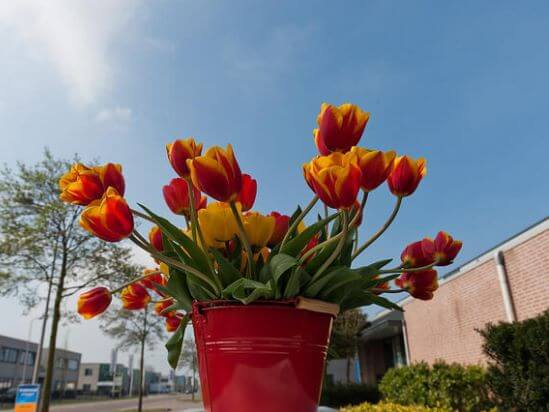

9.2 Propagation by daughter bulbs
Each year, during transplantation, daughter bulbs are separated from the mother plants, disinfected, then dried and examined. If there is damage or signs of disease, it is better to destroy the bulbs, and leave only healthy planting material for further breeding.
You may also be interested in:
- Sweet peas - planting and care, coloring the flowers of an annual plant, growing from seeds at home and in the open field, keeping on the balcony, varieties
- Pogonaterum - photo of indoor plants, home care, planting in open ground, description of varieties, flowering time, reproduction - growing from seeds, when to transplant a plant, watering and feeding, lighting, temperature
- Lavender - photo, planting and caring for a flower in the open field, growing from seeds in a pot, at home, the beneficial properties of lavender oil, flowering time, planting seedlings, plant application
- Indoor ivy - plant care at home, types of ivy, reproduction, flowering time, soil composition for planting indoor plants in pots
Small daughter bulbs in the first 2 - 3 years are grown in a separate place so that they do not interfere with adult plants to develop and form buds. If, during the first 1 - 2 years, young plants get confused to form flowers, then such buds must be removed - thereby accelerating the development of bulbs.
↑ Up,
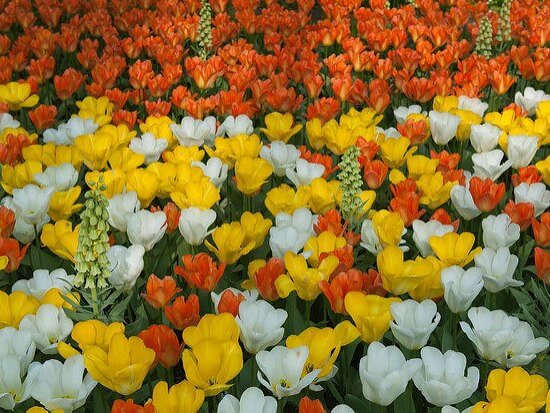

Tulip care, watering and flower feeding
- Tulip care should be started in early spring, when their red shoots just appeared from the ground. In this case, you will have to remove the bulbs of the non-germinated plant, destroying them, because this will make it possible not to get sick with other tulips.
- Watering such flowers should be carried out regularly and abundantly, especially if the weather outside is warm. After 3 weeks after flowering, watering should be stopped, and the soil between the plants should be loosened and weeded.
- The tulip report indicates that the first feeding of such flowers is carried out after the emergence of seedlings.The soil needs to be fertilized a second time before the buds appear. The third dressing of tulips is necessary for them with the active formation of buds. The fourth dressing usually occurs at the beginning of the tulip flowering.
- Weeding and loosening of the soil in the area with these plants is carried out regularly.
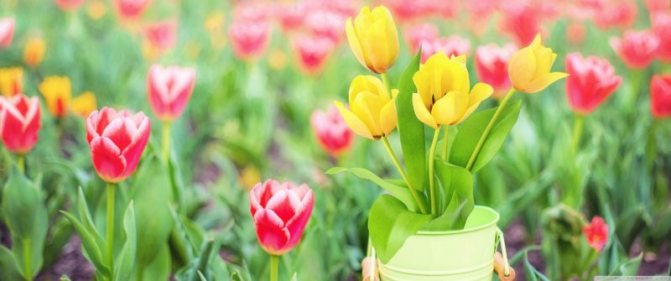

5 transplant
When grown in a garden, tulips can stay in the same area for 3 to 5 years, however, it is better to do an annual transplant. The fact is that the bulbs go several centimeters deeper into the ground every year and they can simply be lost. In addition, at great depths, the root system of the flower cannot breathe. Numerous daughter bulbs will take away all the nutrients from the mother and this will immediately affect flowering.
When transplanting, the planting material is dug up, dried in a warm, well-ventilated place inaccessible to the direct sun. Further, the bulbs are sorted out, separating the rotten or diseased ones - this will prevent the spread of diseases in the flower garden.
↑ Up,
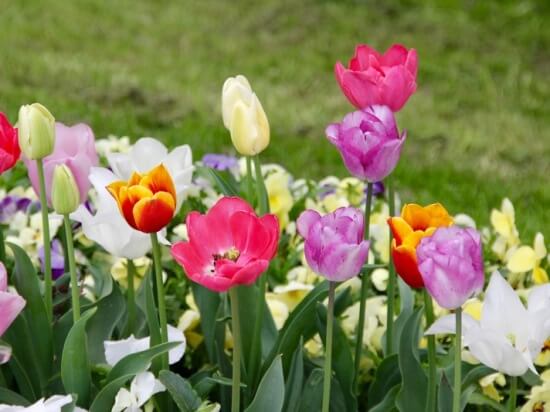

A transplant is carried out after flowering, but until the ground part dies off completely - the leaves can dry completely, but the stem must remain - otherwise the bulbs may not be found.
When replanting, some of the bulbs can be left in the house for later distillation.
In areas where tulips used to be, useful flowers such as marigolds, nasturtium, mustard or calendula are planted for 1 - 2 years - many diseases and pests are afraid of them.
↑ Up,
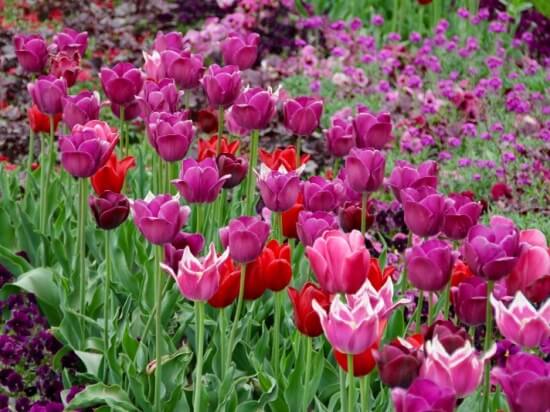

The healing properties of tulips
- The chemical composition of tulips confirms that this plant contains such useful substances as tuliposides A, B and C, as well as the alkaloid tulipine. This is the reason for the antibacterial and antifungal properties of the tulip.
- In folk medicine, this flower is used in the treatment of certain cardiovascular diseases, because tulips have cardiotonic properties.
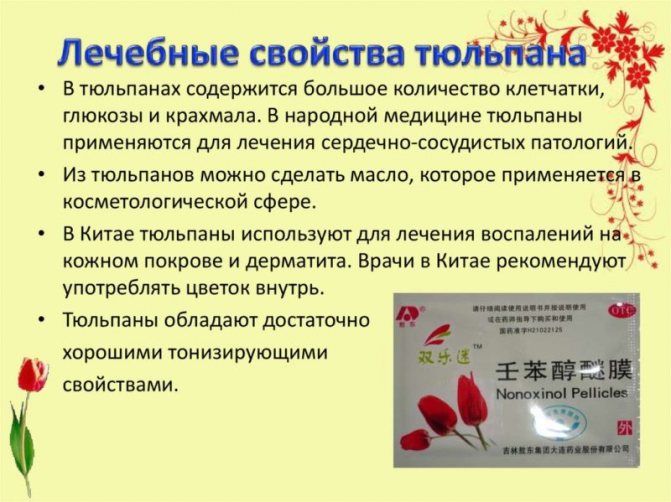

Tulip flowers benefits and treatments
- Chinese folk healers use tulip tinctures for diarrhea, indigestion, various types of poisoning, as well as for tumors.
- Tulip oil is used in the treatment of certain dermatological diseases. It is also used in the manufacture of nourishing face masks in the field of home cosmetology.
- The use of a tulip will be advisable for inflammation of the skin, for rheumatism, for arthritis and for arthrosis.
Read also: The length of the roots of African ficus reaches 120 meters
Harm of tulip flowers and contraindications
- Before being treated with these plants, you need to know that only edible varieties of the tulip flower have medicinal properties. Gunther's tulip, for example, is highly toxic. The Gesmer tulip is also toxic. It is forbidden to consume them inside because of the danger of death and severe intoxication of the body.
- The tulip bulb contains some allergens. With constant contact of a person with this flower, especially in florists, the development of "tulip dermatitis" may be likely. Symptoms of this disease: tingling in the fingers, itching and peeling of the skin, eczema, nail damage.
- The use of tulips is categorically contraindicated during pregnancy, breastfeeding and among children.
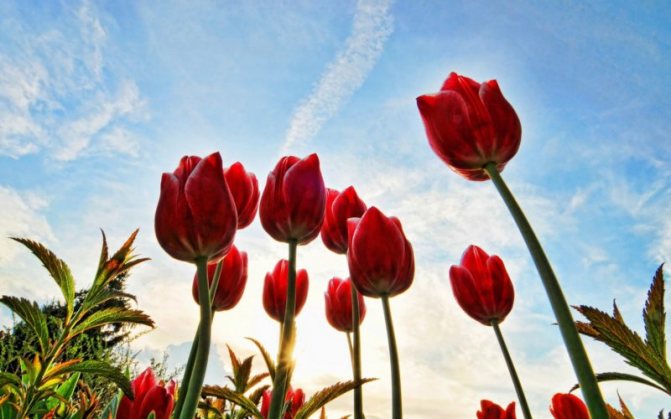

7 storage of bulbs
If necessary, you can store the tulip bulbs for several months before planting.
Previously, the plants are dug up and shaken off the remnants of the old soil. Old, rotten and damaged bulbs are thrown away. The root system is washed in running water and the bulbs are treated with fungicides for half an hour.
After processing, the planting material is dried in a warm and ventilated room for a couple of days.Storage is carried out in a cool room with a temperature of about 17 degrees.
↑ Upward,
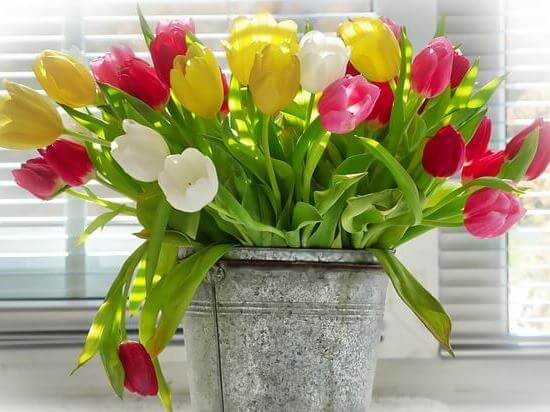

Popular message topics
- Why are punctuation marks needed
Oral and written speech of a person is a complex system of relationships of various structures, without which understanding the text in writing and communication of people would be impossible. However, in order for the meaning of the text to be clear to everyone, it is necessary - Water hardness and elimination
The hardness of water is understood as the presence in it of such physicochemical properties, which are associated with a certain amount of salts of alkaline earth metals contained in water in a dissolved state, most often magnesium or calcium. - Obsolete words
The written and oral speech of a modern person is represented by a huge variety of words that help to correctly express thoughts. Most of them are the words that are familiar to us, people use them every day.


